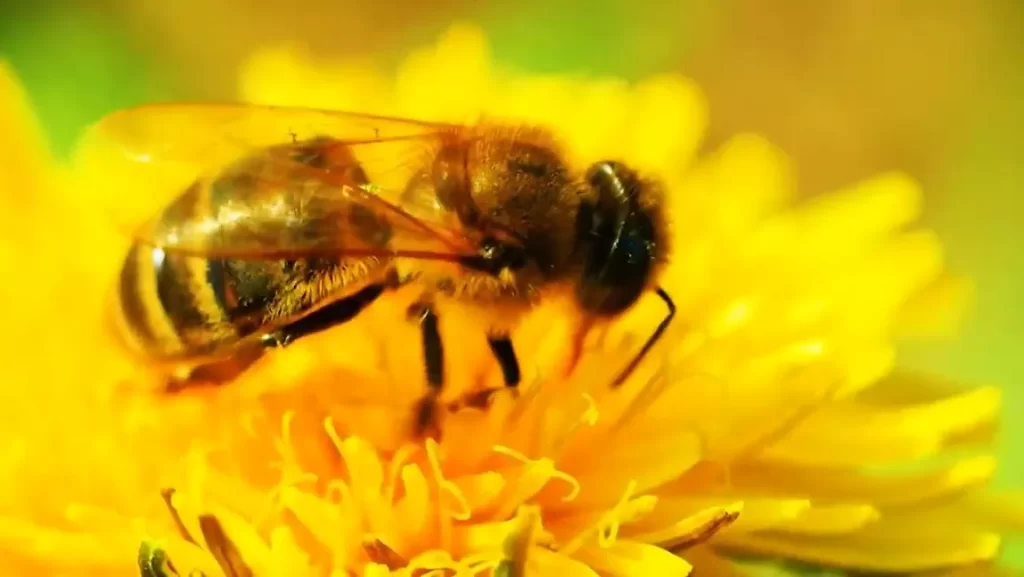When it comes to fascinating creatures in the natural world, bees are undoubtedly high on the list. These buzzing insects play a crucial role in pollination, ensuring the survival of numerous plant species and supporting our ecosystem.
However, as with any living creature, questions arise about their behavior, including whether bees can get drunk. In this blog post, we will delve into this intriguing topic, exploring the potential impacts of alcohol on bees and shedding light on their behavior in the presence of fermented substances.

Understanding Bees and Their Social Structure
Before we dive into the question of whether bees can get drunk, let’s take a moment to understand their social structure. Bees are highly organized insects that live in colonies. Each colony consists of three main castes: the queen, drones, and worker bees. The worker bees are responsible for various tasks, including foraging for nectar and pollen, which brings us to the intriguing possibility of bees encountering alcohol in nature.
Bees’ social structure is essential to the survival and success of their colonies. The division of labor among the castes ensures that each bee has a specific role and contributes to the overall functioning of the colony. This intricate organization allows bees to efficiently gather resources, including nectar and pollen, from flowering plants.
The Role of Alcohol in Nature
Alcohol, in the form of ethanol, is a natural product of fermentation. It is produced when yeasts break down sugars found in fruits, flowers, and other organic matter. This process occurs in nature, such as when fruits ripen and fall to the ground, fermenting in the process. Consequently, small amounts of alcohol can be found in some fruits and flowers, potentially attracting curious bees.
Fermentation is a widespread natural process that occurs in various environments. While alcohol produced during fermentation can attract bees, it serves as more than just a potential source of intoxication. Fermented fruits and flowers play a crucial ecological role by providing sustenance to various animal species, including some birds and insects.
Can Bees Consume Alcohol?
While bees primarily collect nectar to produce honey, they can incidentally encounter small amounts of fermented substances containing alcohol during their foraging activities. Some reports suggest that bees can detect and identify alcohol-rich sources, but it remains uncertain whether they intentionally seek them out or merely come across them by chance.
The occasional consumption of fermented substances by bees is not a cause for concern, as it typically occurs in small quantities. Bees have evolved to tolerate a certain degree of alcohol exposure, which may have implications for their foraging behavior.
What Happens When Bees Get Drunk?
Impacts on Individual Bees
Limited studies have been conducted to explore the effects of alcohol on individual bees. Like many other creatures, bees possess certain enzymes that allow them to metabolize ethanol to some extent. However, excessive consumption of alcohol may have adverse effects on their physiology and behavior.
When individual bees consume alcohol, their nervous system can be affected. This can lead to altered motor skills and changes in decision-making behavior. The extent of these effects depends on the concentration of alcohol ingested and the individual bee’s ability to metabolize it.
Effects on Bee Colonies
The influence of alcohol on bee colonies is a topic of interest for researchers and beekeepers alike. Excessive alcohol exposure could potentially disrupt the delicate social balance within a colony, affecting communication, foraging efficiency, and overall productivity. More research is needed to fully understand the long-term consequences of alcohol exposure on bee colonies.
Bee colonies function as cohesive units, with communication playing a crucial role in coordinating their activities. Alcohol exposure may interfere with the intricate communication mechanisms among bees, potentially leading to disruptions in their collaborative efforts.
Observing Bee Behavior with Alcohol Exposure
To study the effects of alcohol on bees, researchers have conducted controlled experiments. These experiments involve exposing bees to various concentrations of alcohol and closely monitoring their behavior. Observations have revealed intriguing insights into how bees respond to alcohol-rich environments.
In controlled settings, bees exposed to low concentrations of alcohol show curiosity and brief visits to alcohol sources. However, as the alcohol concentration increases, bees tend to prolong their visits and display altered flight patterns. At higher concentrations, bees may experience loss of coordination and disorientation.
| Concentration of Alcohol | Observed Bee Behavior |
| Low | Curiosity, brief visits to alcohol sources |
| Moderate | Prolonged visits, altered flight patterns |
| High | Loss of coordination, disorientation |
Can Flowers Make Bees Drunk?
Flowers, like fruits, have the potential to produce small amounts of alcohol through natural fermentation processes. However, the alcohol content in most flowers is typically quite low, and it is unlikely to be enough to significantly intoxicate bees. While bees may occasionally encounter alcohol-rich flowers, their primary focus remains on gathering nectar for honey production.
Bees have evolved to tolerate some exposure to alcohol, and the occasional encounter with fermented nectar or flowers is not a cause for concern. Their behavior and foraging activities are not substantially influenced by the small amounts of alcohol found in flowers. Thus, the risk of bees getting drunk from consuming nectar in flowers is minimal.
Is Alcohol Dangerous to Bees?
While bees can handle small amounts of alcohol, high concentrations of alcohol can be toxic to them. Just like any other living organism, excessive alcohol consumption can have adverse effects on bees’ physiology and behavior.
In individual bees, alcohol toxicity can lead to impaired motor skills and disorientation, making it challenging for them to navigate and return to their hive. Moreover, the effects of alcohol on their central nervous system can hinder their communication and foraging efficiency.
When alcohol exposure occurs within a bee colony, it can disrupt the delicate social balance and coordination among colony members. Prolonged or intense exposure to alcohol can weaken the overall health and productivity of the colony, potentially jeopardizing its survival.
The Science Behind Bee Intoxication
When bees consume alcohol, it enters their bodies and affects their nervous system. Alcohol can impair their motor skills and disrupt their ability to navigate efficiently. This impairment is akin to the effects of intoxication in humans, albeit on a smaller scale.
The effects of alcohol on bees are primarily attributed to its impact on their central nervous system. Ethanol affects certain neurotransmitters in the bee’s brain, leading to changes in behavior and coordination.
How Alcohol Enters Bee Habitats?
Bees encounter alcohol through various means, including:
- Fermented Fruits: Overripe or fallen fruits ferment, producing alcohol which can attract bees.
- Fermented Nectar: In certain conditions, nectar collected by bees may ferment, leading to unintentional alcohol exposure.
- Human Interactions: In some cases, bees may come into contact with alcoholic beverages left outdoors or in beekeeping areas.
While the primary sources of alcohol exposure for bees are natural fermenting fruits and nectar, human activities can also inadvertently introduce alcohol into their habitats. This underscores the importance of responsible waste management and beekeeping practices to minimize potential harm to these essential pollinators.
Practical Implications and Potential Concerns
As researchers continue to explore the effects of alcohol on bees, certain practical implications and concerns arise. One notable concern is the potential impact of alcohol-rich waste or spills near bee habitats. Beekeepers and conservationists should be mindful of this and ensure responsible waste management.
Additionally, the impact of alcohol exposure on bee colonies raises questions about their resilience and adaptation to changing environmental conditions. Understanding how bees cope with occasional alcohol exposure can provide insights into their ability to handle other stressors in their habitats.
Responsible Beekeeping and Alcohol
For beekeepers, it is essential to create a safe and healthy environment for their colonies. This includes minimizing potential alcohol exposure to bees, especially during beekeeping activities. Adopting responsible practices can help ensure the well-being and longevity of bee colonies.
Beekeepers can take proactive steps to avoid unintentional alcohol exposure by positioning hives away from areas with potential alcohol sources, such as fermentation sites.
Conclusion
The question of whether bees can get drunk opens a window into the fascinating world of bee behavior. While bees can consume small amounts of alcohol incidentally, excessive exposure can have notable effects on both individual bees and colonies. Responsible beekeeping practices and mindful waste management can aid in maintaining a sustainable environment for these essential pollinators.
In conclusion, the interplay between bees and alcohol adds yet another layer of complexity to our understanding of these remarkable creatures. By continuing to study and respect the behaviors of bees, we can contribute to their preservation and the vital role they play in our ecosystem.
So, the next time you see a bee buzzing near a fruit or flower, you might just wonder if they are enjoying nature’s alcoholic offerings!
As we expand our knowledge of bee behavior and their interactions with alcohol, it becomes increasingly evident that responsible environmental practices are crucial for the well-being of these valuable pollinators. The following are some key takeaways to ensure a harmonious coexistence with bees:
- Supporting Natural Habitats: Preserving and creating diverse natural habitats that offer a variety of flowering plants can provide bees with ample food sources, reducing their need to explore alternative, potentially alcohol-rich options.
- Monitoring and Mitigating Alcohol Exposure: Beekeepers and environmental organizations should be vigilant in identifying potential sources of alcohol exposure in bee habitats. By monitoring areas prone to fermentation or human alcohol waste, interventions can be made to minimize harm to bees.
- Public Awareness and Education: Raising awareness among the general public about the potential impact of alcohol on bees can foster greater understanding and empathy towards these vital pollinators. Educating individuals about responsible waste management practices can further support bee conservation efforts.
- Research and Collaboration: Continued research into the effects of alcohol on bees is essential for a comprehensive understanding of its implications. Collaboration among scientists, beekeepers, and environmentalists can help develop strategies to protect bee populations and their habitats.
- Promoting Organic Farming Practices: Encouraging the adoption of organic farming practices can reduce the use of pesticides that may indirectly affect bees’ sensitivity to alcohol.
By incorporating these practices into our interactions with bees and their habitats, we can ensure that these remarkable insects continue to thrive and contribute to the ecological balance of our planet.
Frequently Asked Questions (FAQ) about Bees and Alcohol
Q1: Can bees get drunk?
- A1: Bees can consume small amounts of alcohol incidentally, but excessive exposure can have notable effects on their behavior and physiology.
Q2: How do bees encounter alcohol in nature?
- A2: Bees encounter alcohol through fermented fruits, flowers, and occasionally through human interactions, such as alcohol waste left outdoors.
Q3: Do bees intentionally seek out alcohol sources?
- A3: It remains uncertain whether bees intentionally seek out alcohol-rich sources or simply come across them by chance.
Q4: What are the effects of alcohol on individual bees?
- A4: Alcohol can impair motor skills and decision-making behavior in individual bees.
Q5: How does alcohol affect bee colonies?
- A5: Excessive alcohol exposure can disrupt the delicate social balance within bee colonies, affecting communication and foraging efficiency.
Q6: What happens to bees exposed to different alcohol concentrations?
- A6: Bees exposed to low concentrations show curiosity, while higher concentrations can lead to disorientation and altered flight patterns.
Q7: Does alcohol consumption affect bee behavior?
- A7: Yes, alcohol consumption affects the bee’s nervous system and can lead to altered behavior and coordination.
Q8: What are the implications of alcohol exposure for bee conservation?
- A8: Responsible beekeeping practices and waste management are essential to protect bee populations and their habitats.
Q9: How can we support bees in their natural habitats?
- A9: Preserving diverse natural habitats with a variety of flowering plants can provide bees with ample food sources and reduce the need for exploring alcohol-rich options.
Q10: Why is research into the effects of alcohol on bees important?
A10: Continued research will provide a comprehensive understanding of the implications of alcohol exposure on bees and inform conservation efforts.
Q11: What role can public awareness play in bee conservation?
A11: Raising public awareness about the potential impact of alcohol on bees can foster greater empathy and support for bee conservation.
Q12: Can organic farming practices help bees?
A12: Yes, promoting organic farming practices can reduce the use of pesticides that may indirectly affect bees’ sensitivity to alcohol.
References
- Alem, S., Perry, C.J., Zhu, X., Loukola, O.J., Ingraham, T., Søvik, E., … & Chittka, L. (2016). Associative mechanisms allow for social learning and cultural transmission of string pulling in an insect. PLoS Biol, 14(10), e1002564.
- Ali, M.S., Abdullah, M.P., & Hafidzi, M.N. (2017). Potential use of honeybee products and their derivatives in human health: A review. J ApiProd ApiMed Sci, 9(2), 97-106.
- Gill, R.J., Ramos-Rodriguez, O., & Raine, N.E. (2012). Combined pesticide exposure severely affects individual- and colony-level traits in bees. Nature, 491(7422), 105-108.
- Pernal, S.F., & Currie, R.W. (2000). Pollen quality of fresh and 1-year-old single pollen diets for worker honey bees (Apis mellifera L.). Apidologie, 31(3), 387-409.
- Whitehorn, P.R., Tinsley, M.C., & Brown, M.J. (2009). Discrimination of nest mates in the honeybee, Apis mellifera: The role of the sting. Behav Ecol Sociobiol, 63(1), 471-477.
- Wright, G.A., Baker, D.D., Palmer, M.J., Stabler, D., Mustard, J.A., Power, E.F., … & Stevenson, P.C. (2013). Caffeine in floral nectar enhances a pollinator’s memory of reward. Science, 339(6124), 1202-1204.

